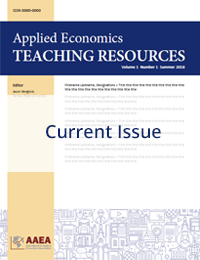Teaching Education Commentary
The Do Now: A Simple, but Effective Active Learning Strategy
LaPorchia A. Collins
Tulane University
JEL Codes: A20, A22
Keywords: Active learning, formative assessment, interactive lecture, self-efficacy
First Published Online: December 8, 2020
Volume 2, Issue 2
View Full Article (PDF) | Request Teaching Notes/Supplemental Materials
Abstract
Students often have difficulty applying concepts discussed in lectures. Using practical guidance that allows for flexibility in implementation, I highlight the Do Now as a short, practice exercise that promotes just-in-time instruction. My approach stresses application of course concepts to improve student self-efficacy and performance. A supplemental teaching note provides additional guidance on implementation.
References
Bandura, A. 1977. “Self-efficacy: Toward a Unifying Theory of Behavioral Change.” Psychological Review 84(2):191–215.
Beatty, I. D., W. J. Gerace, W. J. Leonard, and R. J. Dufresne. 2006. “Designing Effective Questions for Classroom Response System Teaching.” American Journal of Physics 74(1):31–39.
Cauley, K. M., and J. H. McMillan. 2010. “Formative Assessment Techniques to Support Student Motivation and Achievement.” The Clearing House: A Journal of Educational Strategies, Issues and Ideas 83(1):1–6.
Goffe, W. L., and D. Kauper. 2014. “A Survey of Principles Instructors: Why Lecture Prevails.” The Journal of Economic Education 45(4):360–375.
Jones, S. 2007. “Reflections on the Lecture: Outmoded Medium or Instrument of Inspiration?” Journal of Further and Higher Education 31(4):397–406.
Lovo, S. 2016. “Tenure Insecurity and Investment in Soil Conservation. Evidence from Malawi.” World Development 78:219–229.
Maier, M. H., and D. Keenan. 1994. “Teaching Tools: Cooperative Learning in Economics.” Economic Inquiry 32(2):358–361.
Pajares, F. 1996. “Self-efficacy Beliefs in Academic Settings.” Review of Educational Research 66(4):543–578.
Prince, M. 2004. “Does Active Learning Work? A Review of the Research.” Journal of Engineering Education 93(3):223–231.
Rocca, K. A. 2010. “Student Participation in the College Classroom: An Extended Multidisciplinary Literature Review.” Communication Education 59(2):185–213.
Schoenfeld, A. H. 1987. “What’s All the Fuss About Metacognition?” In: A. H. Schoenfeld, ed. Cognitive Science and Mathematics Education. Hillsdale, NJ: Lawrence Erlbaum Associates, pp. 189–215.
Shen, D., and H. Frances. “Do Now.” Retrieved from https://ablconnect.harvard.edu/do-now-research. Last Accessed: August 13, 2019.
Stead, D. R. 2005. “A Review of the One-minute Paper.” Active Learning in Higher Education 6(2):118–131.
Stock, J. H., and M. W. Watson. 2015. Introduction to Econometrics, Update, 3rd ed. New York: Pearson Education, Inc.
Wooldridge, J. M. 2016. Introductory Econometrics: A Modern Approach, 6th ed. Boston: Cengage Learning.
Articles in this issue
Teaching Information Literacy: A Case Study of the Ripple Effect in Teamwork
Christiane Schroeter, Lindsey Higgins, Hannah Hank, and Caitlin Stevenson
Facilitating Higher Order Learning: Examining Student Outcomes after a Course Redesign
Anna Josephson, Larry DeBoer, Dave Nelson, and Angelika Zissimopoulos
Hedging with Futures: An Experiential Learning Game
John Michael Riley
Using Data Analytics and Decision-Making Tools for Agribusiness Education
Matthew S. Elliott and Lisa M. Elliott
Personalizing Online Classes: The Use of Evaluation and Participation Tools
Luis Pena-Lavano
The Do Now: A Simple, but Effective Active Learning Strategy
LaPorchia A. Collins


